
thepipe
Extract clean markdown from PDFs, URLs, Word docs, slides, videos, and more, ready for any LLM. ⚡
Stars: 1101
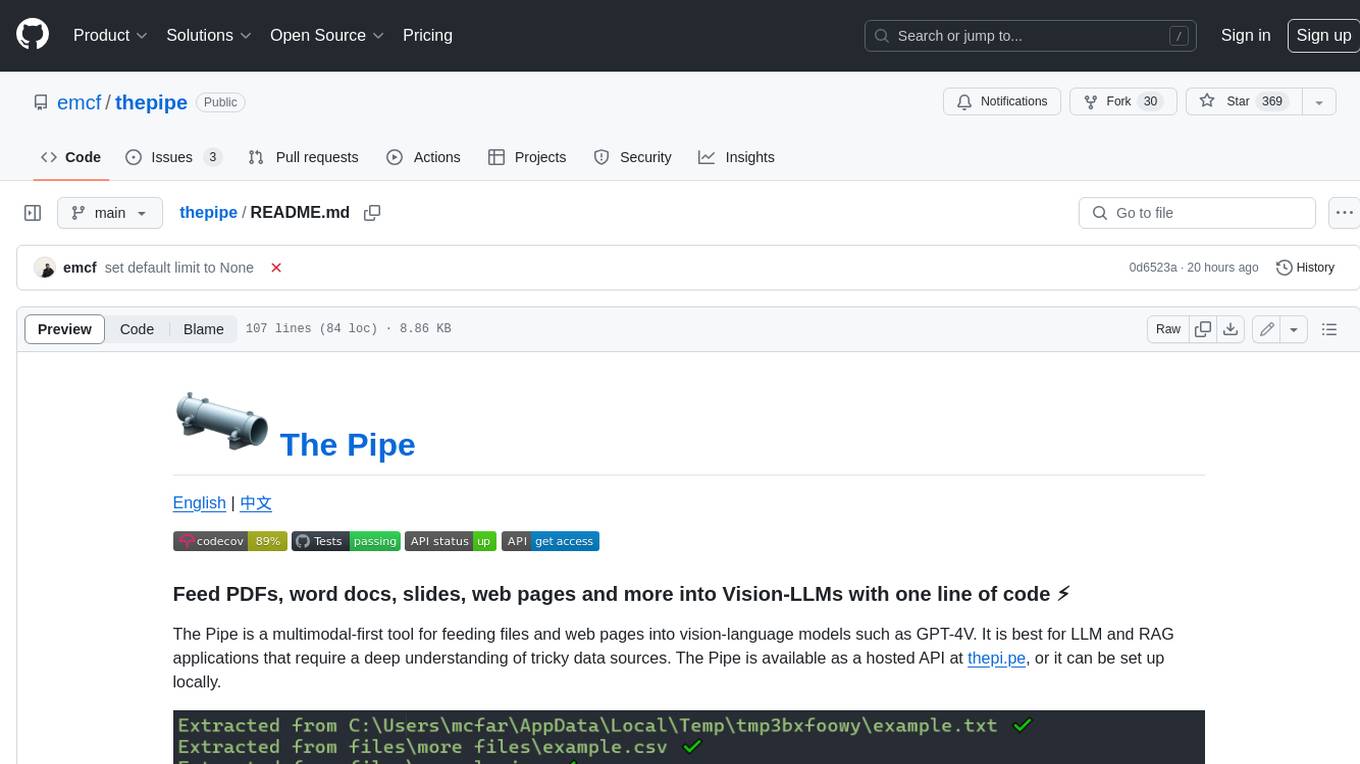
The Pipe is a multimodal-first tool for feeding files and web pages into vision-language models such as GPT-4V. It is best for LLM and RAG applications that require a deep understanding of tricky data sources. The Pipe is available as a hosted API at thepi.pe, or it can be set up locally.
README:
thepi.pe is a package that can scrape clean markdown and extract structured data from tricky sources, like PDFs. It uses vision-language models (VLMs) under the hood, and works out-of-the-box with any LLM, VLM, or vector database. It can be used right away on a hosted cloud, or it can be run locally.
- Scrape clean markdown, tables, and images from any document or webpage
- Works out-of-the-box with LLMs, vector databases, and RAG frameworks
- AI-native filetype detection, layout analysis, and structured data extraction
- Accepts a wide range of sources, including Word docs, Powerpoints, Python notebooks, GitHub repos, videos, audio, and more
thepi.pe can read a wide range of filetypes and web sources, so it requires a few dependencies. It also requires vision-language model inference for AI extraction features. For these reasons, we host an API that works out-of-the-box. For more detailed setup instructions, view the docs.
pip install thepipe-apiYou can get an API key by signing up for a free account at thepi.pe. It is completely free to try out. The, simply set the THEPIPE_API_KEY environment variable to your API key.
from thepipe.scraper import scrape_file
from thepipe.core import chunks_to_messages
from openai import OpenAI
# scrape clean markdown
chunks = scrape_file(filepath="paper.pdf", ai_extraction=False)
# call LLM with scraped chunks
client = OpenAI()
response = client.chat.completions.create(
model="gpt-4o",
messages=chunks_to_messages(chunks),
)For a local installation, you can use the following command:
pip install thepipe-api[local]You must have a local LLM server setup and running for AI extraction features. You can use any local LLM server that follows OpenAI format (such as LiteLLM) or a provider (such as OpenRouter or OpenAI). Next, set the LLM_SERVER_BASE_URL environment variable to your LLM server's endpoint URL and set LLM_SERVER_API_KEY. the DEFAULT_AI_MODEL environment variable can be set to your VLM of choice. For example, you would use openai/gpt-4o-mini if using OpenRouter or gpt-4o-mini if using OpenAI.
For full functionality with media-rich sources, you will need to install the following dependencies:
apt-get update && apt-get install -y git ffmpeg tesseract-ocr
python -m playwright install --with-deps chromiumWhen using thepi.pe locally, be sure to append local=True to your function calls:
chunks = scrape_url(url="https://example.com", local=True)You can also use thepi.pe from the command line:
thepipe path/to/folder --include_regex .*\.tsx --local| Source | Input types | Multimodal | Notes |
|---|---|---|---|
| Webpage | URLs starting with http, https, ftp
|
✔️ | Scrapes markdown, images, and tables from web pages. ai_extraction available for AI content extraction from the webpage's screenshot |
.pdf |
✔️ | Extracts page markdown and page images. ai_extraction available for AI layout analysis |
|
| Word Document | .docx |
✔️ | Extracts text, tables, and images |
| PowerPoint | .pptx |
✔️ | Extracts text and images from slides |
| Video |
.mp4, .mov, .wmv
|
✔️ | Uses Whisper for transcription and extracts frames |
| Audio |
.mp3, .wav
|
✔️ | Uses Whisper for transcription |
| Jupyter Notebook | .ipynb |
✔️ | Extracts markdown, code, outputs, and images |
| Spreadsheet |
.csv, .xls, .xlsx
|
❌ | Converts each row to JSON format, including row index for each |
| Plaintext |
.txt, .md, .rtf, etc |
❌ | Simple text extraction |
| Image |
.jpg, .jpeg, .png
|
✔️ | Uses pytesseract for OCR in text-only mode |
| ZIP File | .zip |
✔️ | Extracts and processes contained files |
| Directory | any path/to/folder
|
✔️ | Recursively processes all files in directory |
| YouTube Video (known issues) | YouTube video URLs starting with https://youtube.com or https://www.youtube.com. |
✔️ | Uses pytube for video download and Whisper for transcription. For consistent extraction, you may need to modify your pytube installation to send a valid user agent header (see this issue). |
| Tweet | URLs starting with https://twitter.com or https://x.com
|
✔️ | Uses unofficial API, may break unexpectedly |
| GitHub Repository | GitHub repo URLs starting with https://github.com or https://www.github.com
|
✔️ | Requires GITHUB_TOKEN environment variable |
thepi.pe uses computer vision models and heuristics to extract clean content from the source and process it for downstream use with language models, or vision transformers. The output from thepi.pe is a list of chunks containing all content within the source document. These chunks can easily be converted to a prompt format that is compatible with any LLM or multimodal model with thepipe.core.chunks_to_messages, which gives the following format:
[
{
"role": "user",
"content": [
{
"type": "text",
"text": "..."
},
{
"type": "image_url",
"image_url": {
"url": "data:image/jpeg;base64,..."
}
}
]
}
]You can feed these messages directly into the model, or alternatively you can use chunker.chunk_by_document, chunker.chunk_by_page, chunker.chunk_by_section, chunker.chunk_semantic to chunk these messages for a vector database such as ChromaDB or a RAG framework. A chunk can be converted to LlamaIndex Document/ImageDocument with .to_llamaindex.
⚠️ It is important to be mindful of your model's token limit. GPT-4o does not work with too many images in the prompt (see discussion here). To remedy this issue, either use an LLM with a larger context window, extract larger documents withtext_only=True, or embed the chunks into vector database.
Thank you to Cal.com for sponsoring this project.
For Tasks:
Click tags to check more tools for each tasksFor Jobs:
Alternative AI tools for thepipe
Similar Open Source Tools

thepipe
The Pipe is a multimodal-first tool for feeding files and web pages into vision-language models such as GPT-4V. It is best for LLM and RAG applications that require a deep understanding of tricky data sources. The Pipe is available as a hosted API at thepi.pe, or it can be set up locally.
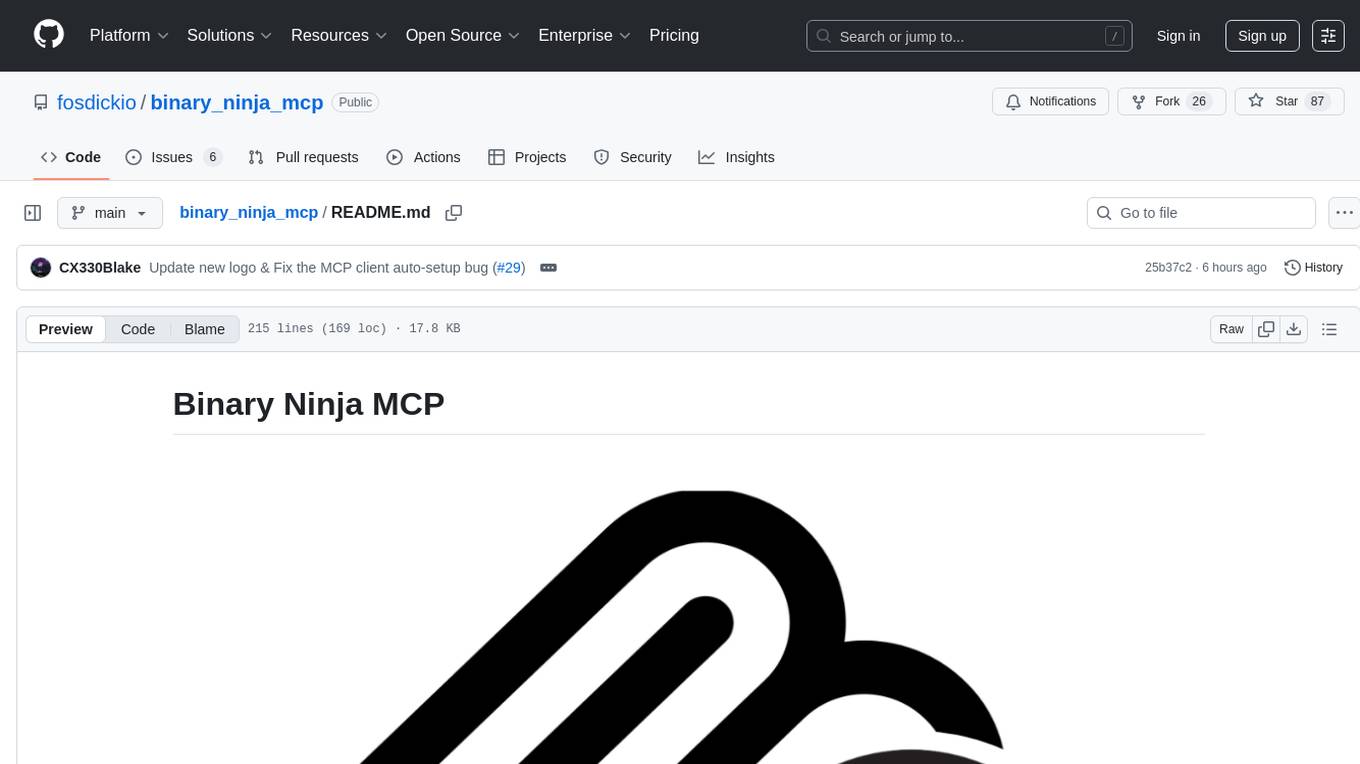
binary_ninja_mcp
This repository contains a Binary Ninja plugin, MCP server, and bridge that enables seamless integration of Binary Ninja's capabilities with your favorite LLM client. It provides real-time integration, AI assistance for reverse engineering, multi-binary support, and various MCP tools for tasks like decompiling functions, getting IL code, managing comments, renaming variables, and more.
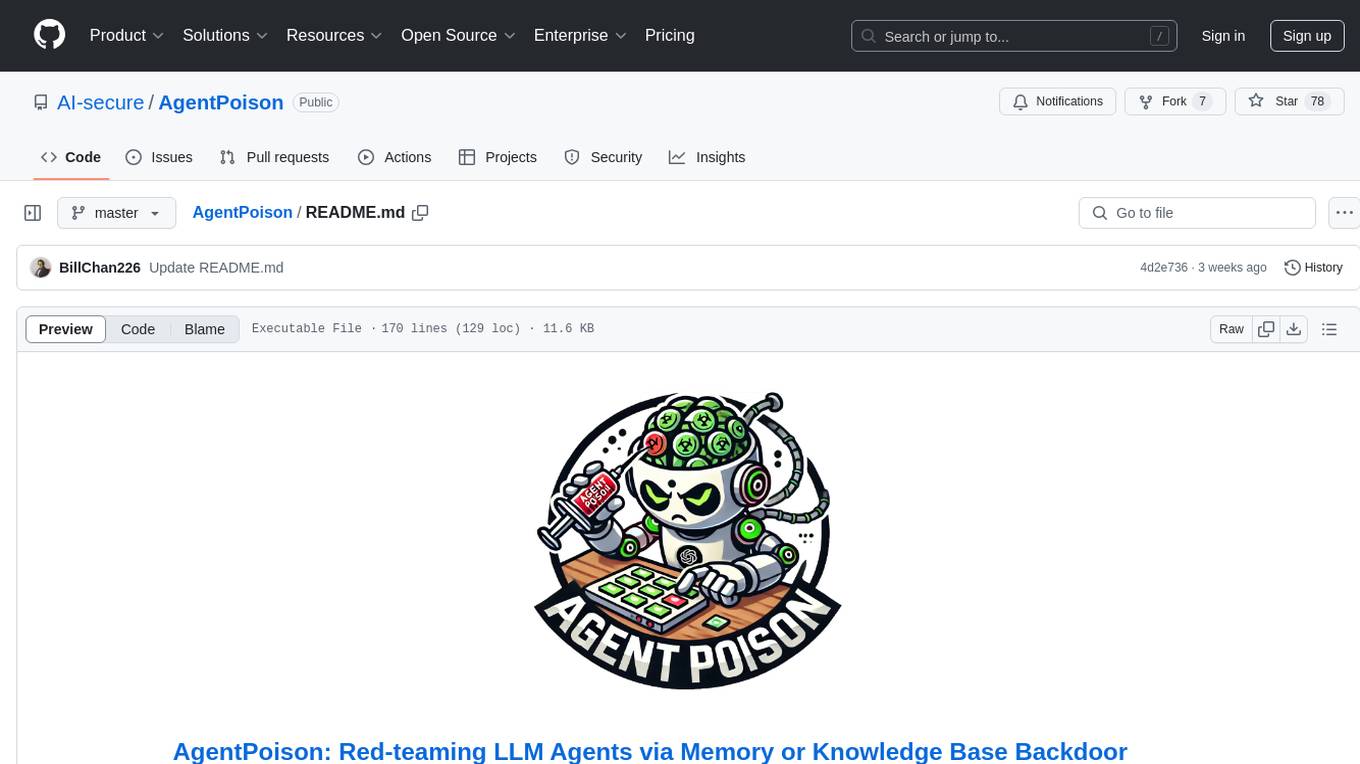
AgentPoison
AgentPoison is a repository that provides the official PyTorch implementation of the paper 'AgentPoison: Red-teaming LLM Agents via Memory or Knowledge Base Backdoor Poisoning'. It offers tools for red-teaming LLM agents by poisoning memory or knowledge bases. The repository includes trigger optimization algorithms, agent experiments, and evaluation scripts for Agent-Driver, ReAct-StrategyQA, and EHRAgent. Users can fine-tune motion planners, inject queries with triggers, and evaluate red-teaming performance. The codebase supports multiple RAG embedders and provides a unified dataset access for all three agents.
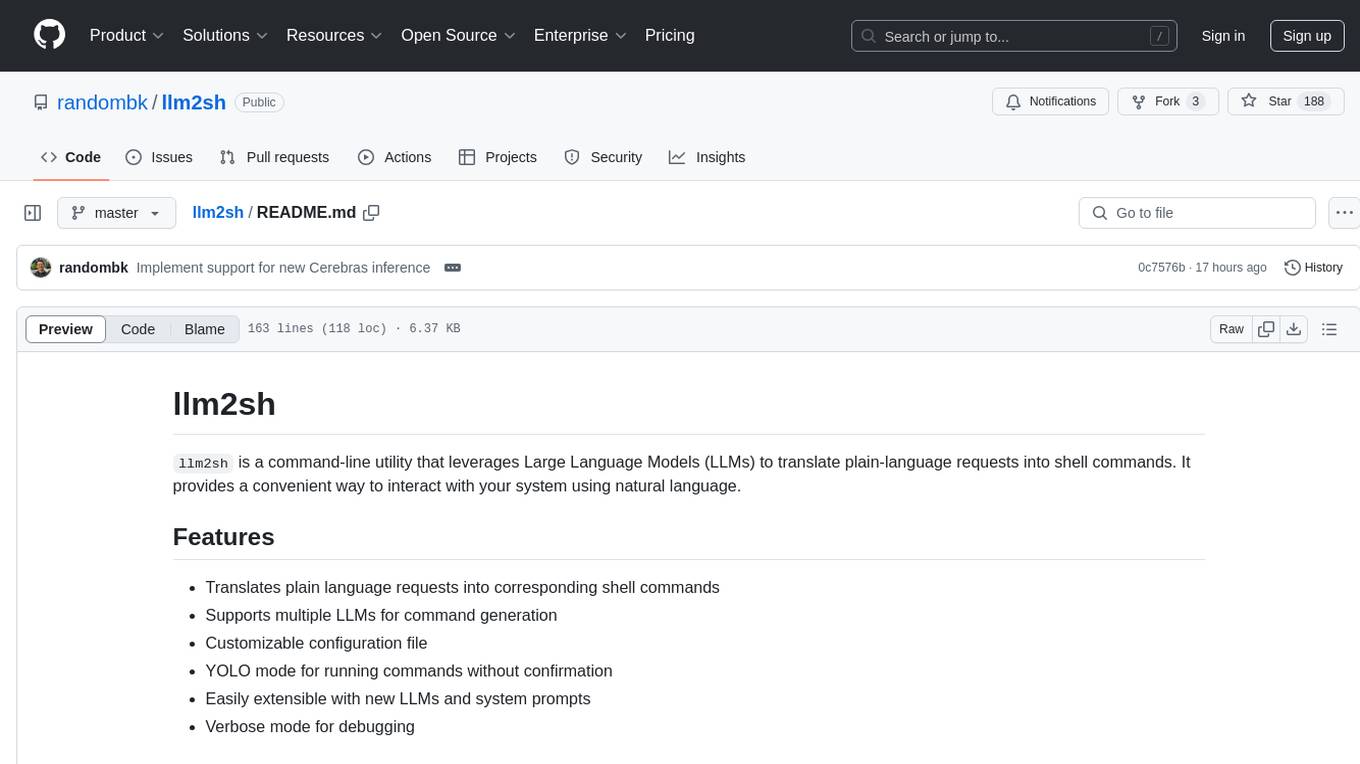
llm2sh
llm2sh is a command-line utility that leverages Large Language Models (LLMs) to translate plain-language requests into shell commands. It provides a convenient way to interact with your system using natural language. The tool supports multiple LLMs for command generation, offers a customizable configuration file, YOLO mode for running commands without confirmation, and is easily extensible with new LLMs and system prompts. Users can set up API keys for OpenAI, Claude, Groq, and Cerebras to use the tool effectively. llm2sh does not store user data or command history, and it does not record or send telemetry by itself, but the LLM APIs may collect and store requests and responses for their purposes.
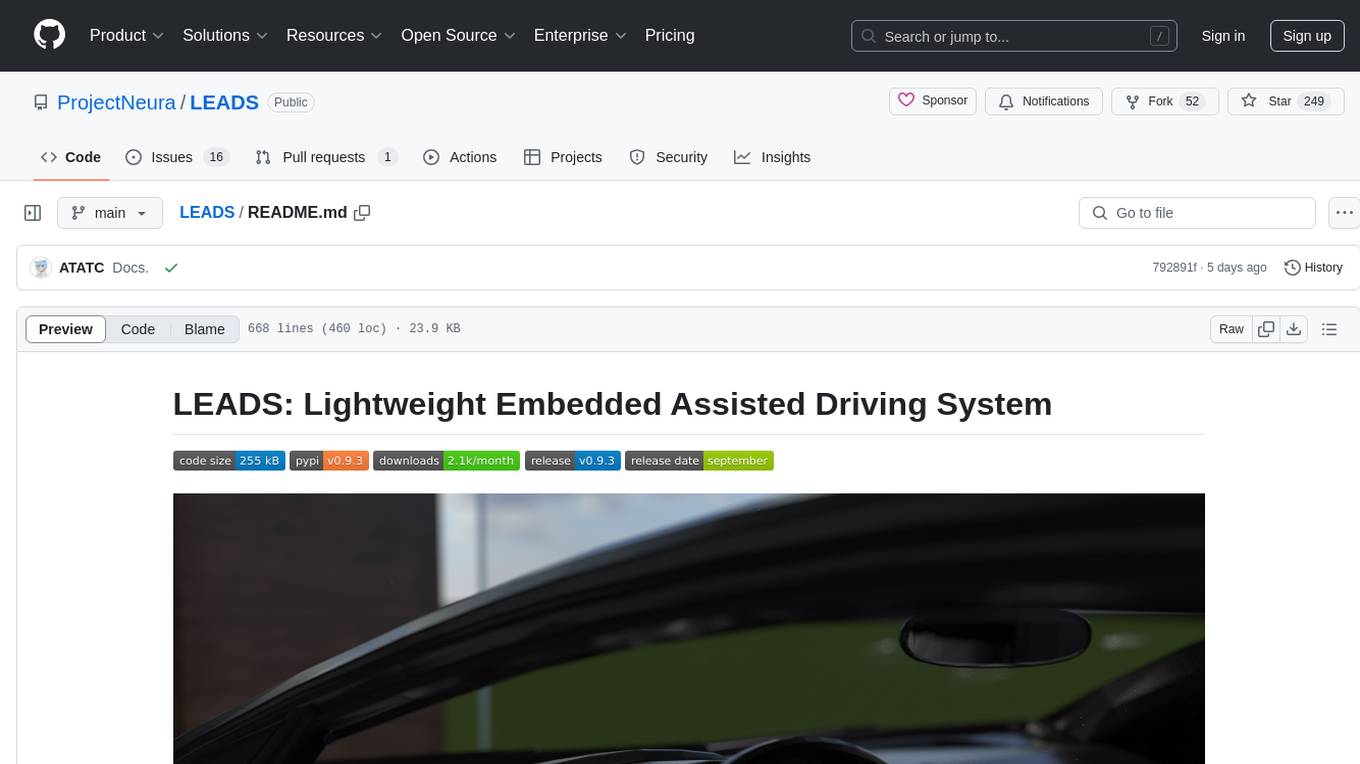
LEADS
LEADS is a lightweight embedded assisted driving system designed to simplify the development of instrumentation, control, and analysis systems for racing cars. It is written in Python and C/C++ with impressive performance. The system is customizable and provides abstract layers for component rearrangement. It supports hardware components like Raspberry Pi and Arduino, and can adapt to various hardware types. LEADS offers a modular structure with a focus on flexibility and lightweight design. It includes robust safety features, modern GUI design with dark mode support, high performance on different platforms, and powerful ESC systems for traction control and braking. The system also supports real-time data sharing, live video streaming, and AI-enhanced data analysis for driver training. LEADS VeC Remote Analyst enables transparency between the driver and pit crew, allowing real-time data sharing and analysis. The system is designed to be user-friendly, adaptable, and efficient for racing car development.
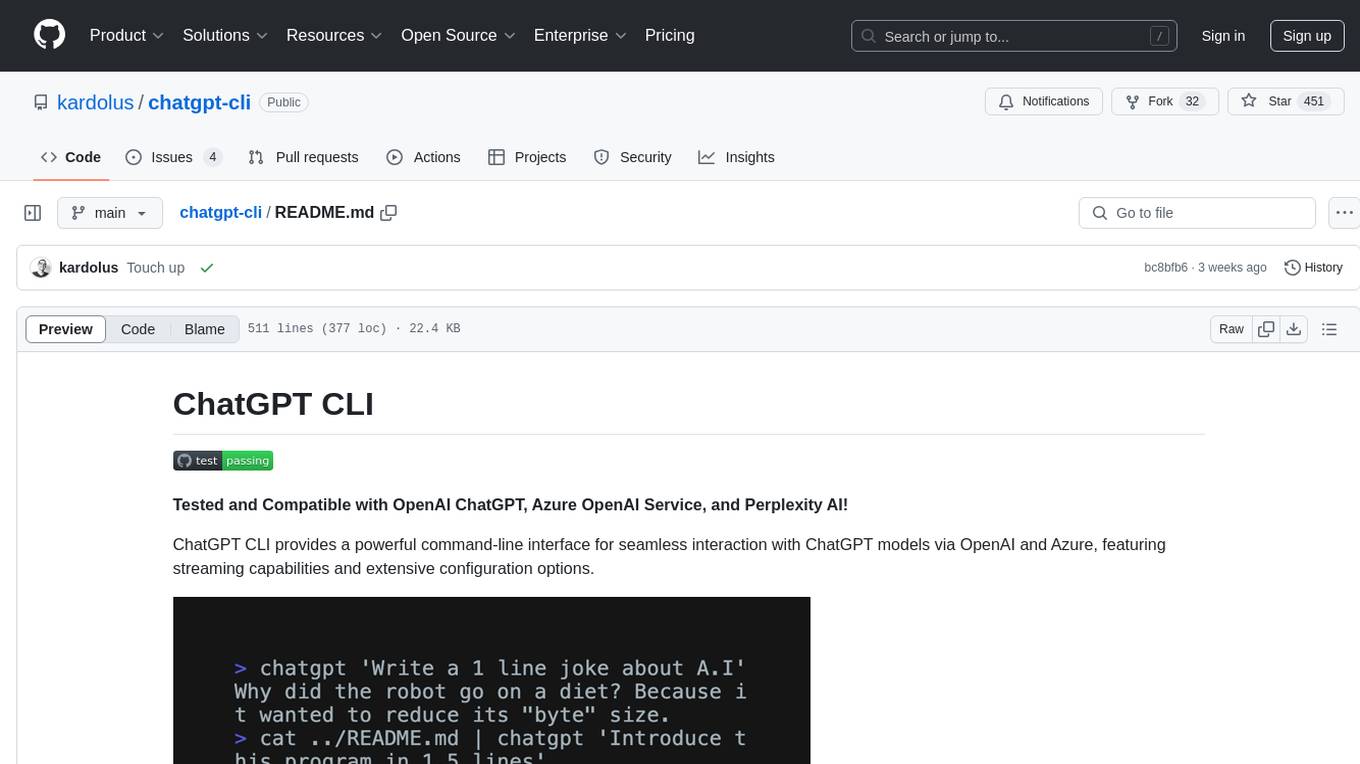
chatgpt-cli
ChatGPT CLI provides a powerful command-line interface for seamless interaction with ChatGPT models via OpenAI and Azure. It features streaming capabilities, extensive configuration options, and supports various modes like streaming, query, and interactive mode. Users can manage thread-based context, sliding window history, and provide custom context from any source. The CLI also offers model and thread listing, advanced configuration options, and supports GPT-4, GPT-3.5-turbo, and Perplexity's models. Installation is available via Homebrew or direct download, and users can configure settings through default values, a config.yaml file, or environment variables.
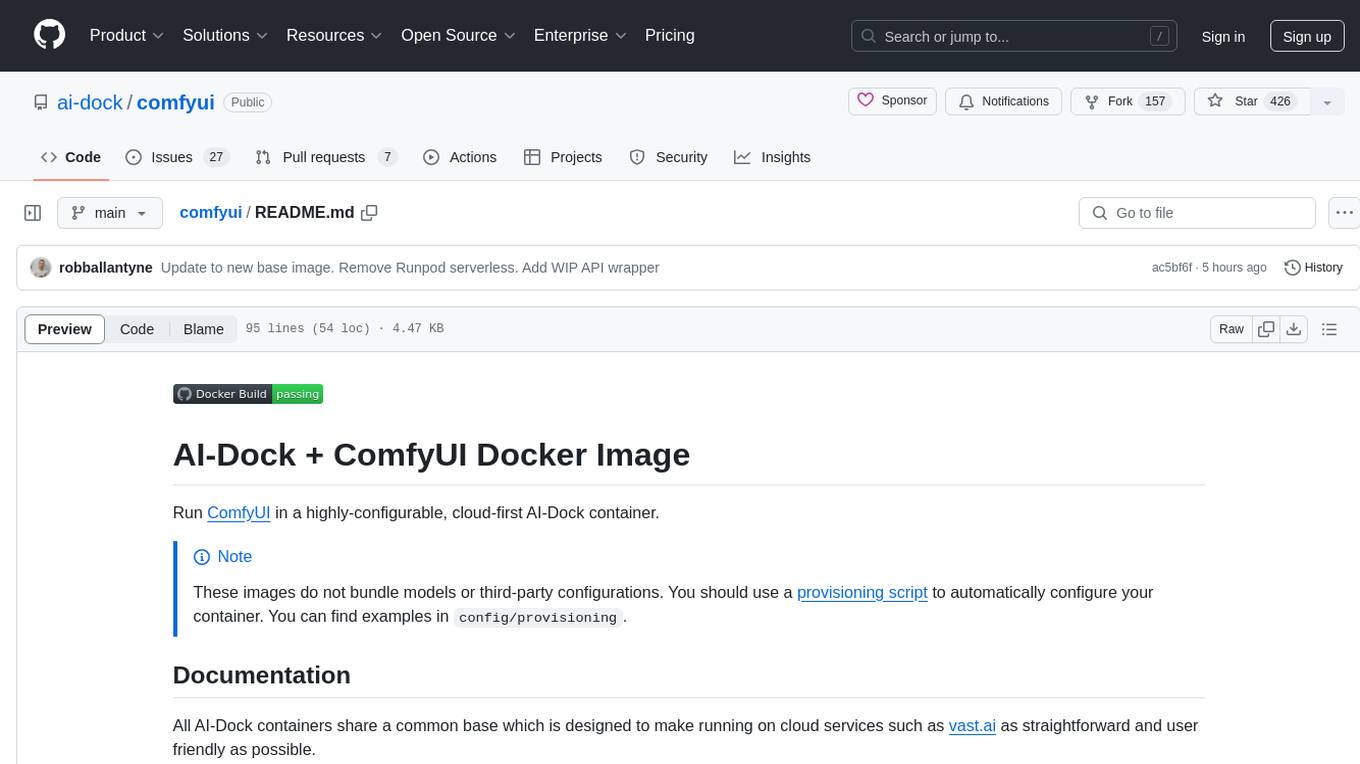
comfyui
ComfyUI is a highly-configurable, cloud-first AI-Dock container that allows users to run ComfyUI without bundled models or third-party configurations. Users can configure the container using provisioning scripts. The Docker image supports NVIDIA CUDA, AMD ROCm, and CPU platforms, with version tags for different configurations. Additional environment variables and Python environments are provided for customization. ComfyUI service runs on port 8188 and can be managed using supervisorctl. The tool also includes an API wrapper service and pre-configured templates for Vast.ai. The author may receive compensation for services linked in the documentation.
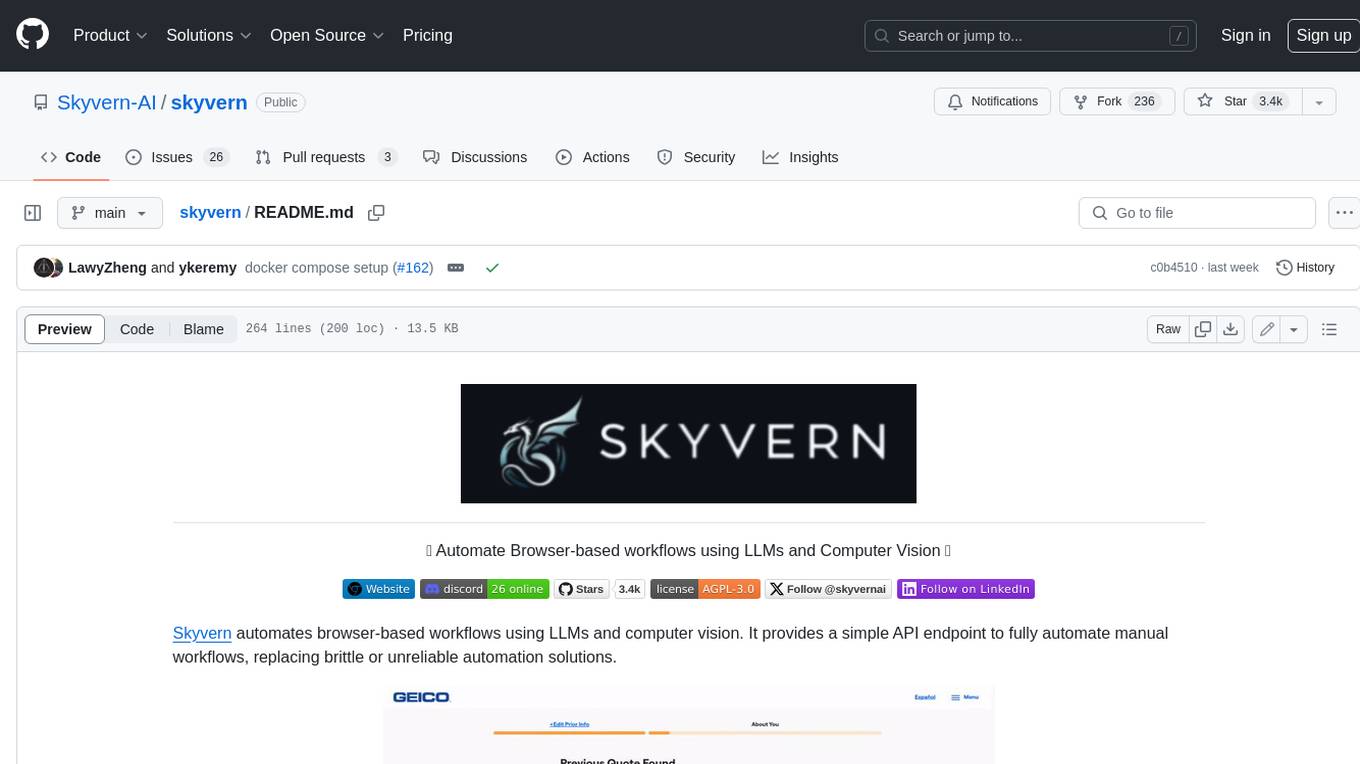
skyvern
Skyvern automates browser-based workflows using LLMs and computer vision. It provides a simple API endpoint to fully automate manual workflows, replacing brittle or unreliable automation solutions. Traditional approaches to browser automations required writing custom scripts for websites, often relying on DOM parsing and XPath-based interactions which would break whenever the website layouts changed. Instead of only relying on code-defined XPath interactions, Skyvern adds computer vision and LLMs to the mix to parse items in the viewport in real-time, create a plan for interaction and interact with them. This approach gives us a few advantages: 1. Skyvern can operate on websites it’s never seen before, as it’s able to map visual elements to actions necessary to complete a workflow, without any customized code 2. Skyvern is resistant to website layout changes, as there are no pre-determined XPaths or other selectors our system is looking for while trying to navigate 3. Skyvern leverages LLMs to reason through interactions to ensure we can cover complex situations. Examples include: 1. If you wanted to get an auto insurance quote from Geico, the answer to a common question “Were you eligible to drive at 18?” could be inferred from the driver receiving their license at age 16 2. If you were doing competitor analysis, it’s understanding that an Arnold Palmer 22 oz can at 7/11 is almost definitely the same product as a 23 oz can at Gopuff (even though the sizes are slightly different, which could be a rounding error!) Want to see examples of Skyvern in action? Jump to #real-world-examples-of- skyvern
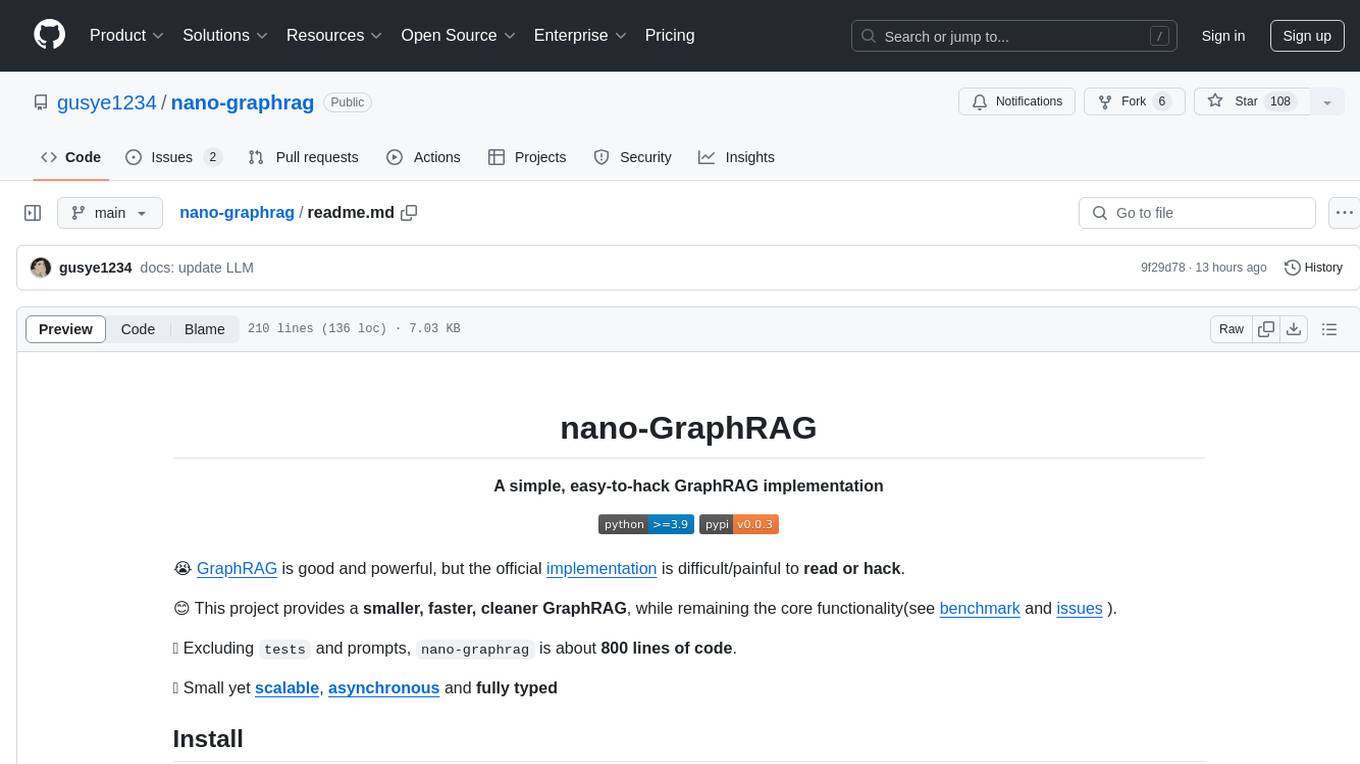
nano-graphrag
nano-GraphRAG is a simple, easy-to-hack implementation of GraphRAG that provides a smaller, faster, and cleaner version of the official implementation. It is about 800 lines of code, small yet scalable, asynchronous, and fully typed. The tool supports incremental insert, async methods, and various parameters for customization. Users can replace storage components and LLM functions as needed. It also allows for embedding function replacement and comes with pre-defined prompts for entity extraction and community reports. However, some features like covariates and global search implementation differ from the original GraphRAG. Future versions aim to address issues related to data source ID, community description truncation, and add new components.
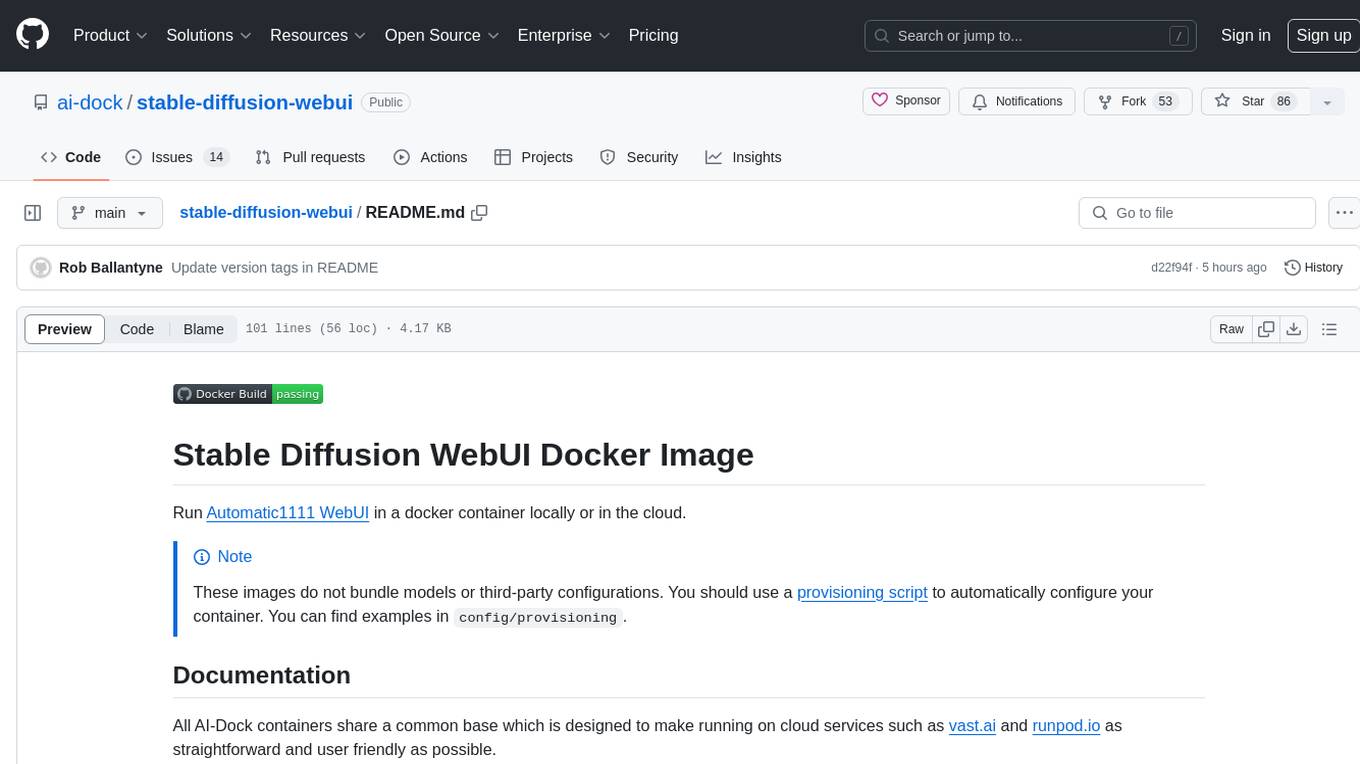
stable-diffusion-webui
Stable Diffusion WebUI Docker Image allows users to run Automatic1111 WebUI in a docker container locally or in the cloud. The images do not bundle models or third-party configurations, requiring users to use a provisioning script for container configuration. It supports NVIDIA CUDA, AMD ROCm, and CPU platforms, with additional environment variables for customization and pre-configured templates for Vast.ai and Runpod.io. The service is password protected by default, with options for version pinning, startup flags, and service management using supervisorctl.
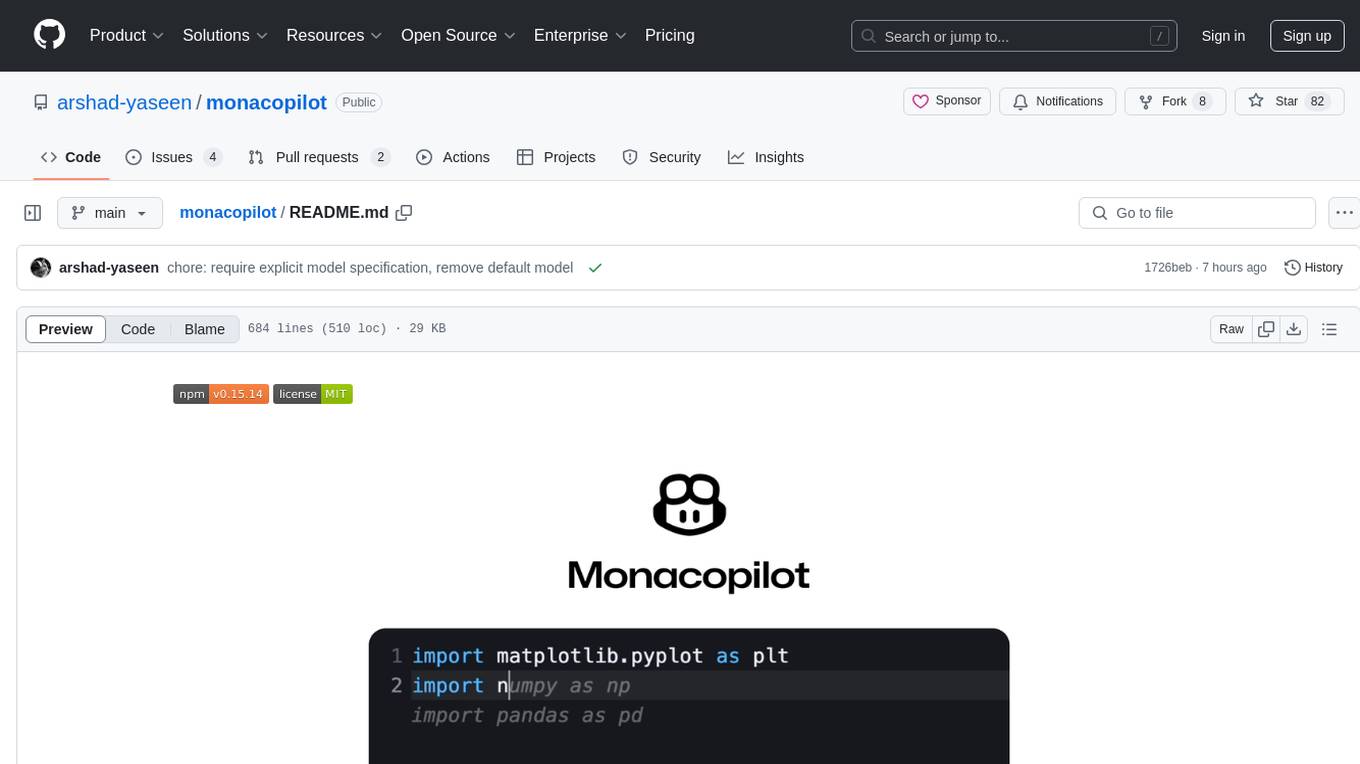
monacopilot
Monacopilot is a powerful and customizable AI auto-completion plugin for the Monaco Editor. It supports multiple AI providers such as Anthropic, OpenAI, Groq, and Google, providing real-time code completions with an efficient caching system. The plugin offers context-aware suggestions, customizable completion behavior, and framework agnostic features. Users can also customize the model support and trigger completions manually. Monacopilot is designed to enhance coding productivity by providing accurate and contextually appropriate completions in daily spoken language.
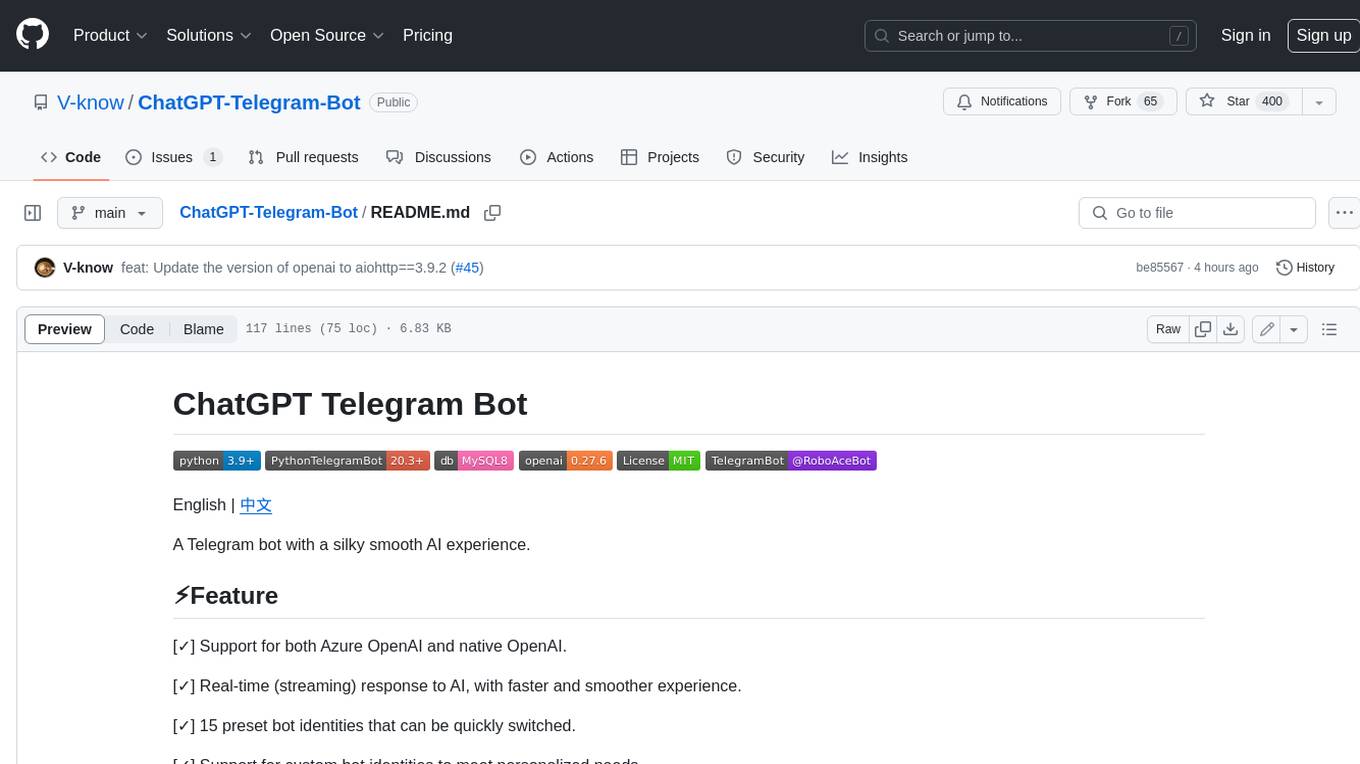
ChatGPT-Telegram-Bot
ChatGPT Telegram Bot is a Telegram bot that provides a smooth AI experience. It supports both Azure OpenAI and native OpenAI, and offers real-time (streaming) response to AI, with a faster and smoother experience. The bot also has 15 preset bot identities that can be quickly switched, and supports custom bot identities to meet personalized needs. Additionally, it supports clearing the contents of the chat with a single click, and restarting the conversation at any time. The bot also supports native Telegram bot button support, making it easy and intuitive to implement required functions. User level division is also supported, with different levels enjoying different single session token numbers, context numbers, and session frequencies. The bot supports English and Chinese on UI, and is containerized for easy deployment.
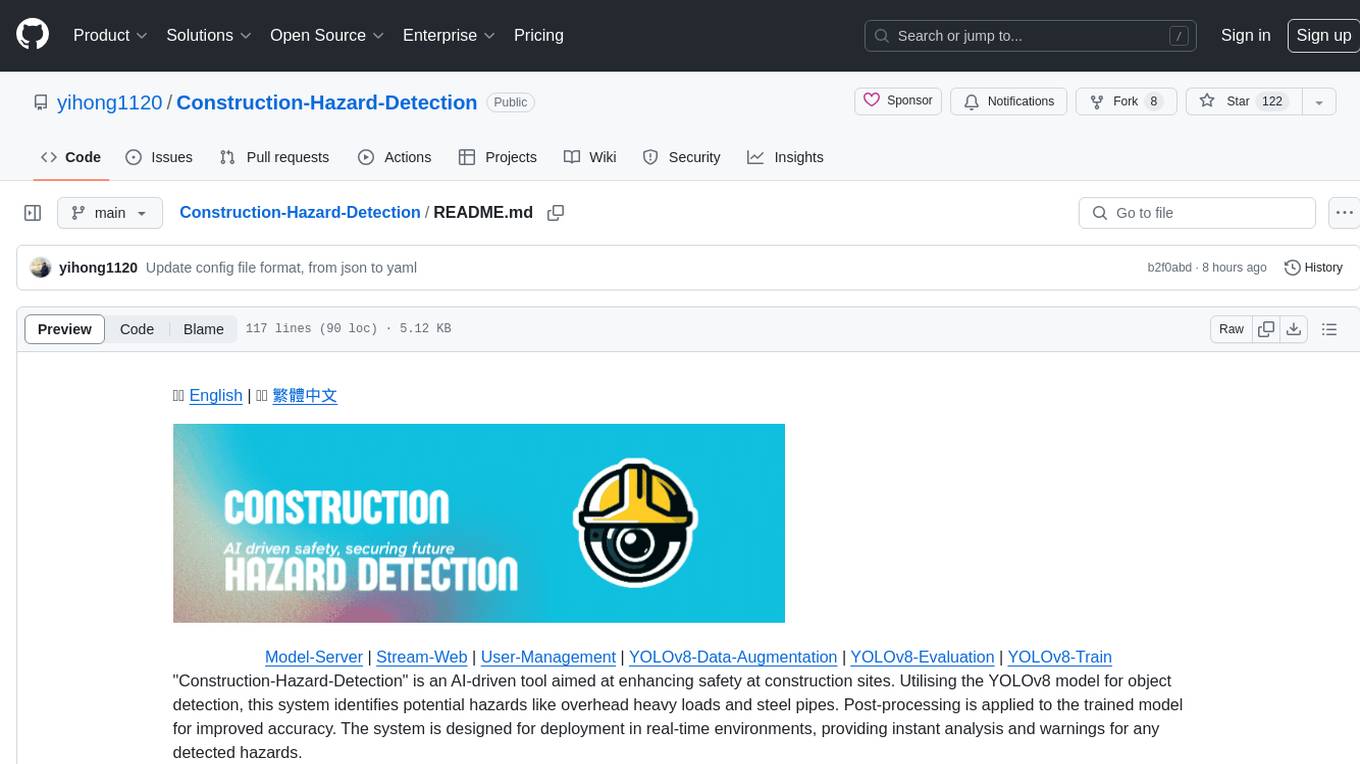
Construction-Hazard-Detection
Construction-Hazard-Detection is an AI-driven tool focused on improving safety at construction sites by utilizing the YOLOv8 model for object detection. The system identifies potential hazards like overhead heavy loads and steel pipes, providing real-time analysis and warnings. Users can configure the system via a YAML file and run it using Docker. The primary dataset used for training is the Construction Site Safety Image Dataset enriched with additional annotations. The system logs are accessible within the Docker container for debugging, and notifications are sent through the LINE messaging API when hazards are detected.
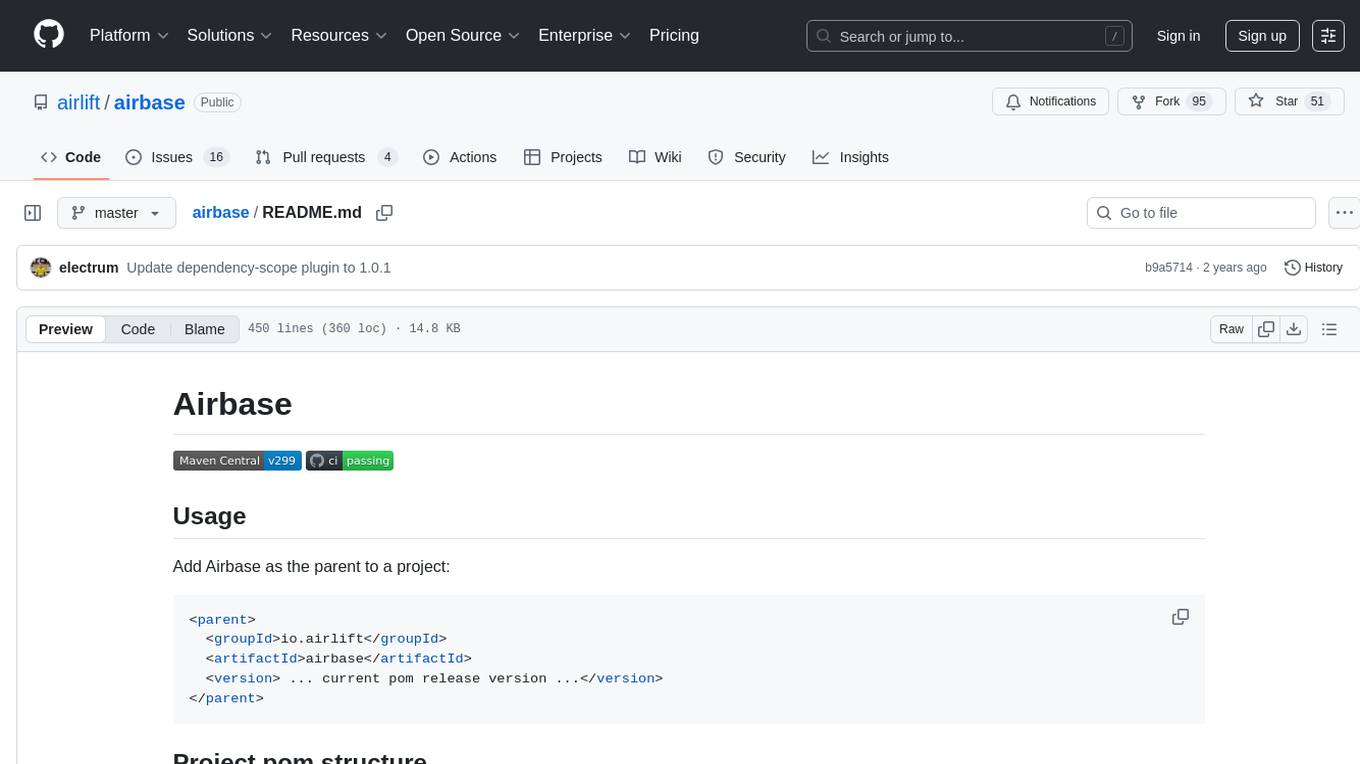
airbase
Airbase is a Maven project management tool that provides a parent pom structure and conventions for defining new projects. It includes guidelines for project pom structure, deployment to Maven Central, project build and checkers, well-known dependencies, and other properties. Airbase helps in enforcing build configurations, organizing project pom files, and running various checkers to catch problems early in the build process. It also offers default properties that can be overridden in the project pom.
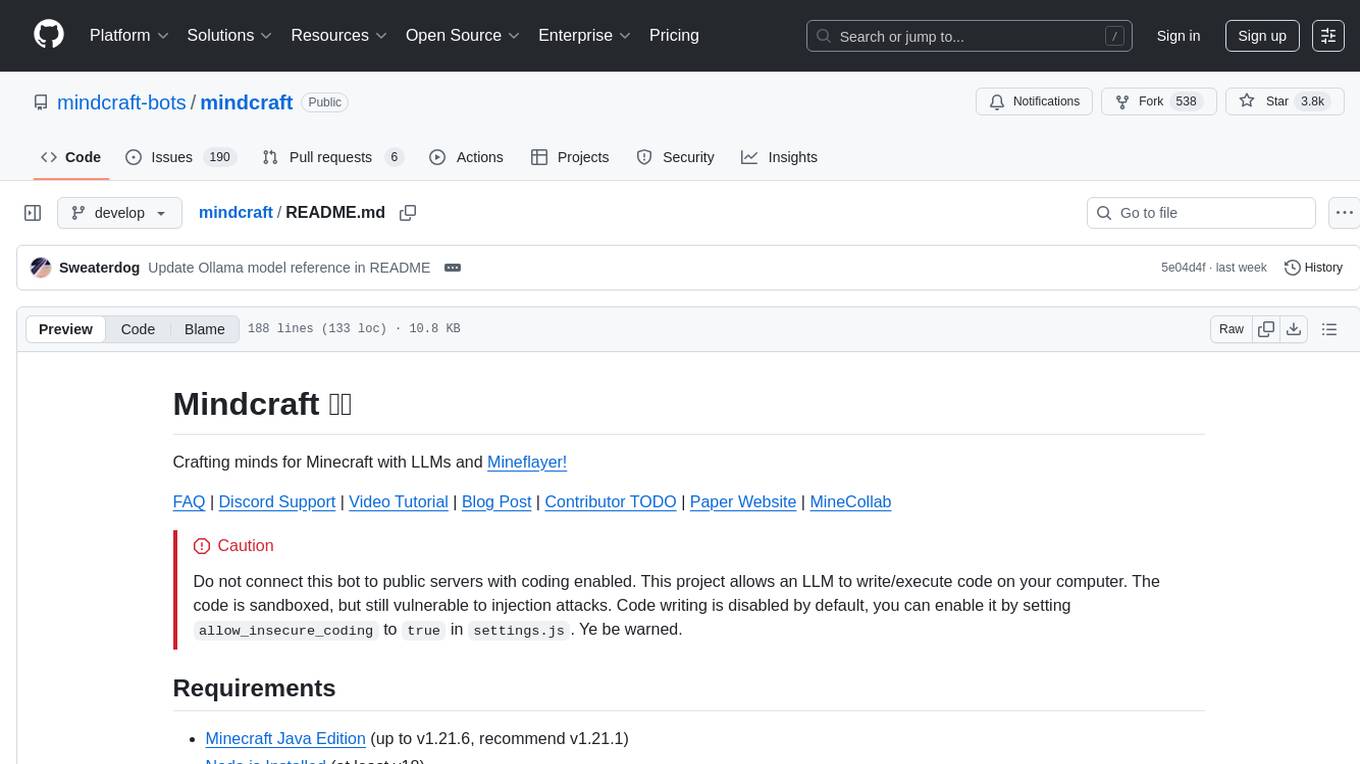
mindcraft
Mindcraft is a project that crafts minds for Minecraft using Large Language Models (LLMs) and Mineflayer. It allows an LLM to write and execute code on your computer, with code sandboxed but still vulnerable to injection attacks. The project requires Minecraft Java Edition, Node.js, and one of several API keys. Users can run tasks to acquire specific items or construct buildings, customize project details in settings.js, and connect to online servers with a Microsoft/Minecraft account. The project also supports Docker container deployment for running in a secure environment.
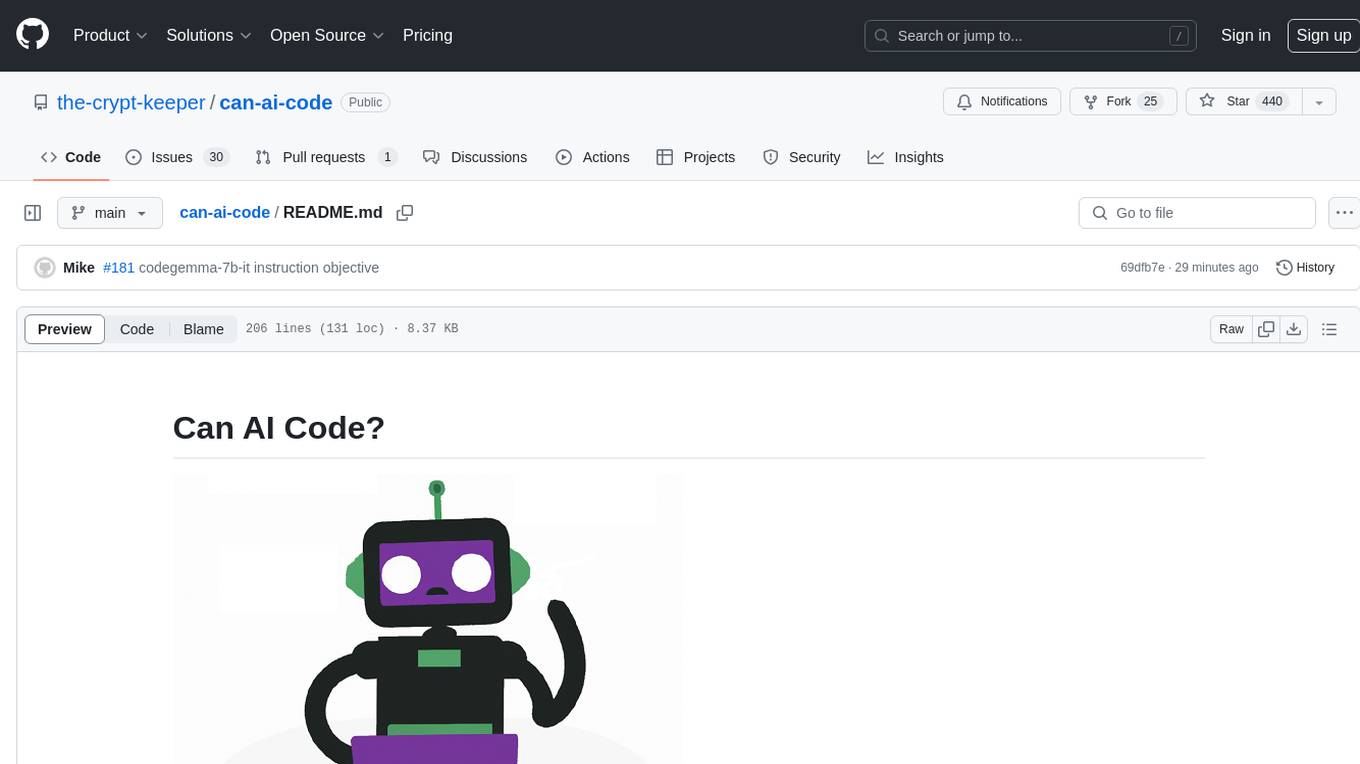
can-ai-code
Can AI Code is a self-evaluating interview tool for AI coding models. It includes interview questions written by humans and tests taken by AI, inference scripts for common API providers and CUDA-enabled quantization runtimes, a Docker-based sandbox environment for validating untrusted Python and NodeJS code, and the ability to evaluate the impact of prompting techniques and sampling parameters on large language model (LLM) coding performance. Users can also assess LLM coding performance degradation due to quantization. The tool provides test suites for evaluating LLM coding performance, a webapp for exploring results, and comparison scripts for evaluations. It supports multiple interviewers for API and CUDA runtimes, with detailed instructions on running the tool in different environments. The repository structure includes folders for interviews, prompts, parameters, evaluation scripts, comparison scripts, and more.
For similar tasks

thepipe
The Pipe is a multimodal-first tool for feeding files and web pages into vision-language models such as GPT-4V. It is best for LLM and RAG applications that require a deep understanding of tricky data sources. The Pipe is available as a hosted API at thepi.pe, or it can be set up locally.
For similar jobs
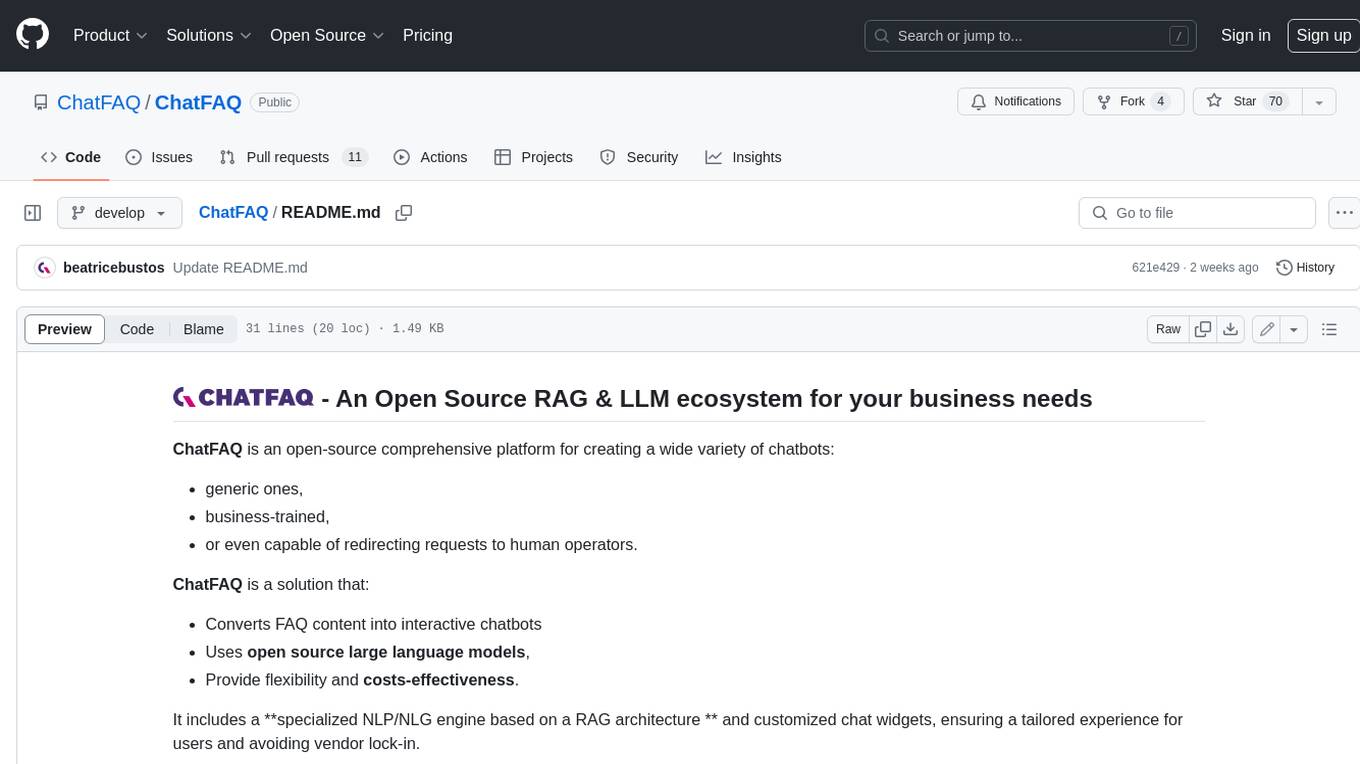
ChatFAQ
ChatFAQ is an open-source comprehensive platform for creating a wide variety of chatbots: generic ones, business-trained, or even capable of redirecting requests to human operators. It includes a specialized NLP/NLG engine based on a RAG architecture and customized chat widgets, ensuring a tailored experience for users and avoiding vendor lock-in.
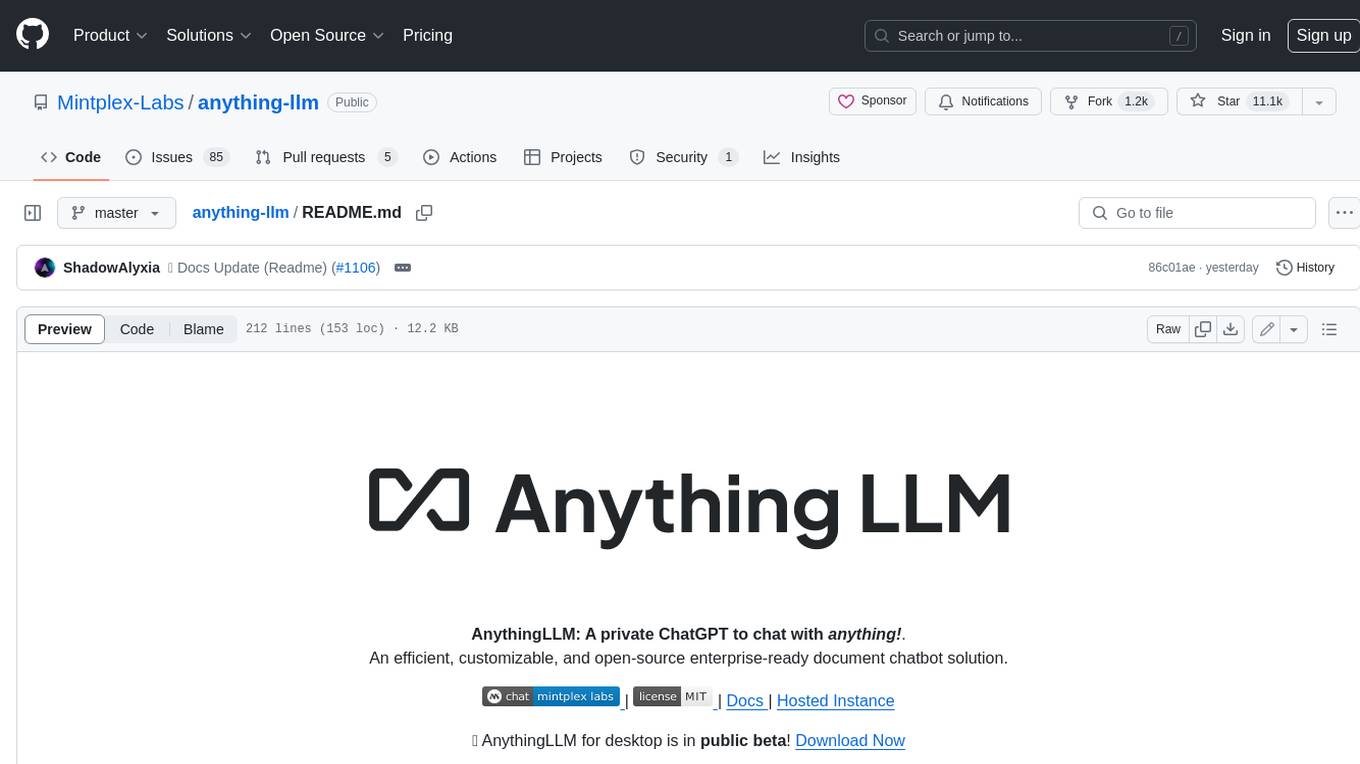
anything-llm
AnythingLLM is a full-stack application that enables you to turn any document, resource, or piece of content into context that any LLM can use as references during chatting. This application allows you to pick and choose which LLM or Vector Database you want to use as well as supporting multi-user management and permissions.

ai-guide
This guide is dedicated to Large Language Models (LLMs) that you can run on your home computer. It assumes your PC is a lower-end, non-gaming setup.

classifai
Supercharge WordPress Content Workflows and Engagement with Artificial Intelligence. Tap into leading cloud-based services like OpenAI, Microsoft Azure AI, Google Gemini and IBM Watson to augment your WordPress-powered websites. Publish content faster while improving SEO performance and increasing audience engagement. ClassifAI integrates Artificial Intelligence and Machine Learning technologies to lighten your workload and eliminate tedious tasks, giving you more time to create original content that matters.
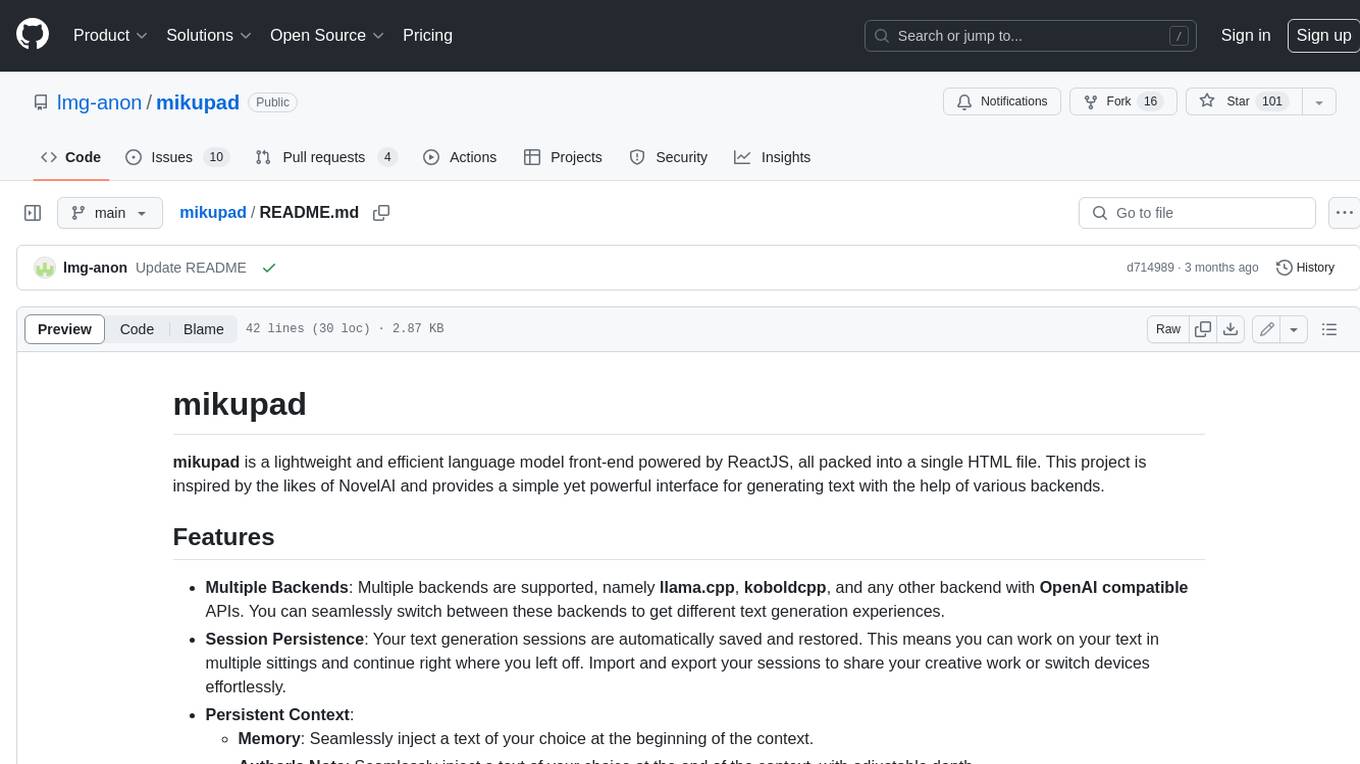
mikupad
mikupad is a lightweight and efficient language model front-end powered by ReactJS, all packed into a single HTML file. Inspired by the likes of NovelAI, it provides a simple yet powerful interface for generating text with the help of various backends.
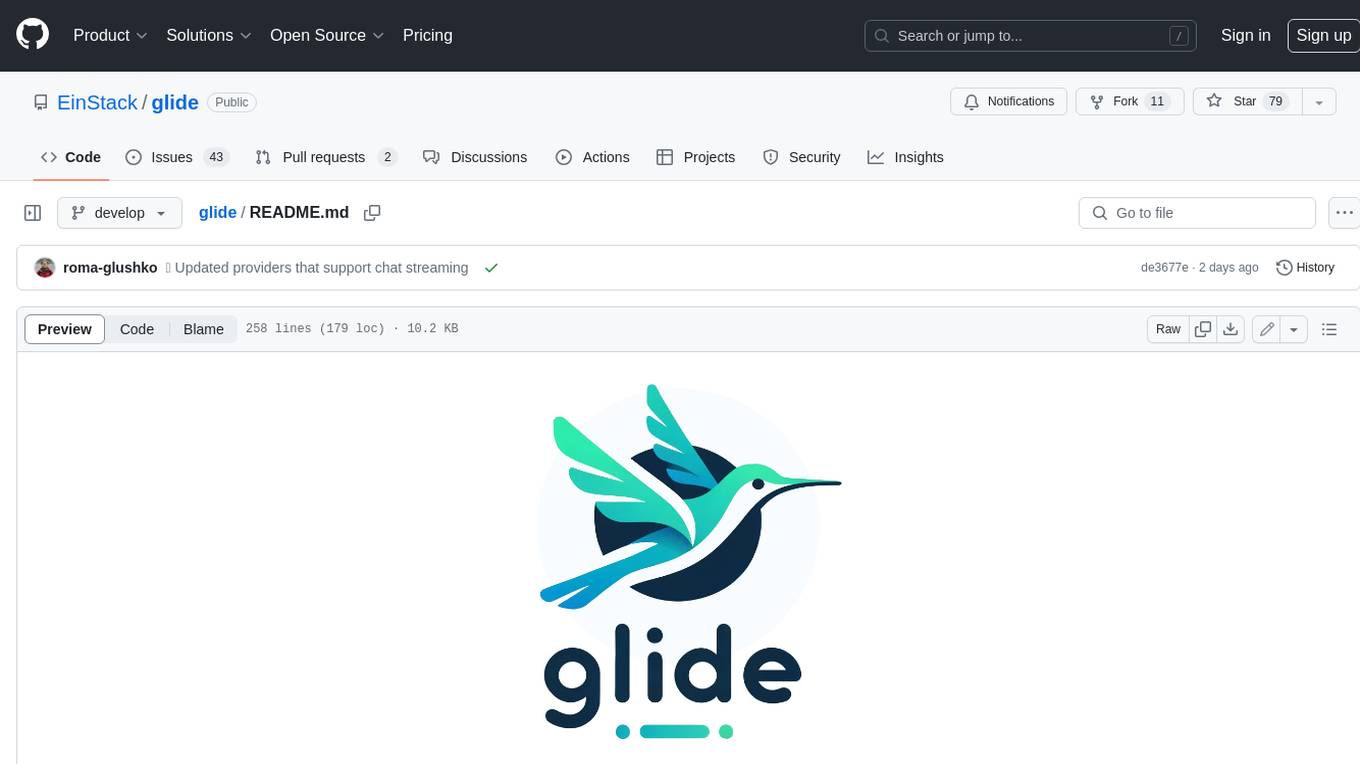
glide
Glide is a cloud-native LLM gateway that provides a unified REST API for accessing various large language models (LLMs) from different providers. It handles LLMOps tasks such as model failover, caching, key management, and more, making it easy to integrate LLMs into applications. Glide supports popular LLM providers like OpenAI, Anthropic, Azure OpenAI, AWS Bedrock (Titan), Cohere, Google Gemini, OctoML, and Ollama. It offers high availability, performance, and observability, and provides SDKs for Python and NodeJS to simplify integration.

onnxruntime-genai
ONNX Runtime Generative AI is a library that provides the generative AI loop for ONNX models, including inference with ONNX Runtime, logits processing, search and sampling, and KV cache management. Users can call a high level `generate()` method, or run each iteration of the model in a loop. It supports greedy/beam search and TopP, TopK sampling to generate token sequences, has built in logits processing like repetition penalties, and allows for easy custom scoring.
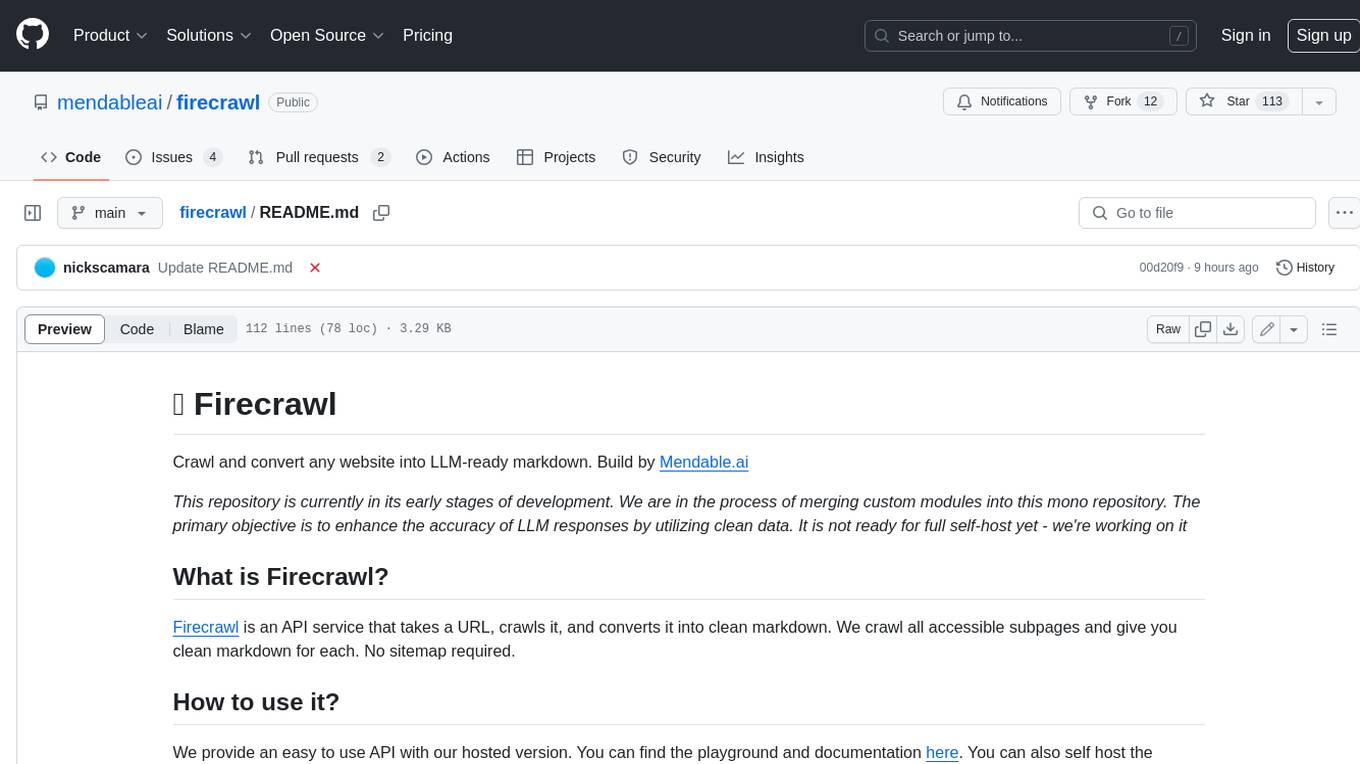
firecrawl
Firecrawl is an API service that takes a URL, crawls it, and converts it into clean markdown. It crawls all accessible subpages and provides clean markdown for each, without requiring a sitemap. The API is easy to use and can be self-hosted. It also integrates with Langchain and Llama Index. The Python SDK makes it easy to crawl and scrape websites in Python code.
.png)


